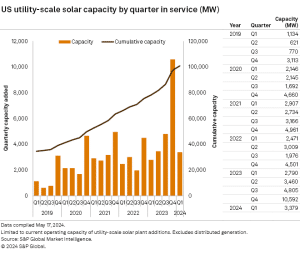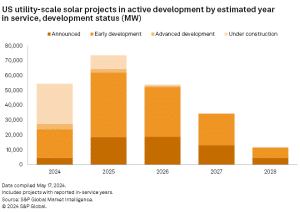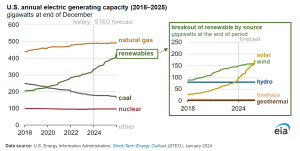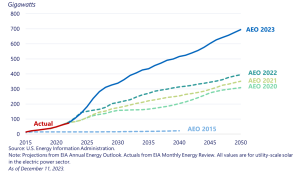The first quarter of 2024 marked a significant milestone for the U.S. solar industry, with installations rising by 21% year-over-year, according to S&P Global Commodity Insights data. This surge has pushed the nation’s cumulative solar capacity past the 100 GW mark.
This is a testament to the accelerating adoption of renewable energy driven by favorable policies and market dynamics. Per S&P Global Market Intelligence data, developers installed 3,379 MW of utility-scale solar during this period, boosting the total solar capacity to an impressive 100,883 MW.
What Makes Solar Energy Shine Brighter
The increase in solar installations can be largely attributed to the Inflation Reduction Act (IRA) and its associated incentives. These incentives have boosted the solar industry, enabling companies to capitalize on financial benefits and invest heavily in solar infrastructure.
US Energy Secretary Jennifer Granholm recently noted that wind and solar energy could surpass coal generation for the first time in US history. She highlighted the ongoing trend towards cleaner energy sources, aiming to achieve 80% clean energy on the path to 100% clean electricity by 2035.
Solar power is leading in the energy landscape, with around 56GW capacity of new additions in 2024.
Sam Huntington, director of North American power and renewables analysis at S&P Global Commodity Insights, emphasized the robust growth trajectory of solar, saying that:
“In a lot of ways, solar is on [an] absolute tear, and we think it will continue at that pace. Solar is going to be doing a lot of the heavy lifting for the next seven years and continue.”
The Solar Energy Industries Association (SEIA) reports that there are now 5 million solar projects in the U.S. These include both utility-scale and distributed solar installations.
- In perspective, the US solar industry displaces 198 million metric tons of carbon dioxide each year. That’s equivalent to shutting down 53 coal-fired power plants. Notably, the amount of reduced CO2 emissions (22 billion gallons of gas) can fuel traveling to the sun and back.
SEIA projects the 5M solar installations to double, reaching 10 million by 2030 and tripling by 2034. This rapid expansion highlights the growing acceptance and integration of solar power across various sectors of the economy.
Project developers have ambitious plans for 2024, aiming to add an additional 54,484 MW of new solar capacity. This pipeline includes 4,626 MW of announced projects, 19,278 MW in early development, 3,578 MW in advanced development, and a substantial 27,002 MW already under construction.
More broadly, 228,197 MW of additional solar capacity is in various stages of development, projected to be completed by 2028, according to S&P Global data.
Project Development, Key Projects, and Regional Insights
Understanding the stages of project development is crucial for grasping the scale and progress of solar installations. S&P Global Market Intelligence categorizes projects under construction once building activities have commenced, excluding mere site preparation.
Advanced development requires projects to meet at least two of the following criteria:
- securing financing,
- signing power purchase agreements,
- obtaining necessary permits,
- securing equipment, or having a contractor on board.
Early development begins with the permitting process, and announced projects are listed in interconnection queues with accompanying public announcements or permitting actions.
The first quarter of 2024 saw the completion of the ten largest solar projects, totaling 1,912 MW, with Texas leading the way. Notable among these are the IP Lumina I Solar Project (Jade Solar) and IP Lumina II Solar Project (Andromeda Solar). They collectively added about 627 MW of solar capacity.
These projects, owned by Intersect Power LLC, have secured renewable energy credits through agreements with two undisclosed companies.
Another remarkable solar project is the California Valley Solar Ranch (CVSR), situated in San Luis Obispo County, California. It’s among the most ambitious solar initiatives to date. Owned by NRG Energy and operated by SunPower, a leading developer of utility-scale solar projects, it boasts a capacity to produce 580 MW of power, showcasing the significant scalability of solar energy projects.
Nevada’s contribution to the solar boom, the Copper Mountain Solar Facility developed by Sempra Generation, has consistently increased its capacity, now standing at 802 MW. Its ongoing expansion demonstrates the potential of solar projects to meet rising energy demands effectively.
Solar Energy Future Outlook
The U.S. solar industry is poised for continued growth, driven by strong policy support, technological advancements, and increasing market demand. As the nation progresses toward its renewable energy goals, solar power will play an increasing role in the energy mix. The current trajectory suggests a bright future for solar energy, with significant capacity additions expected in the coming years.
Based on new solar projects coming online this year, the US Energy Information Administration (EIA) forecasts substantial growth in solar power generation. Specifically, EIA anticipates a 75% increase from 163 billion kilowatt-hours (kWh) in 2023 to 286 billion kWh by 2025.
Moreover, planned solar projects could significantly boost the solar capacity operated by the electric power sector in the country. Specifically, the capacity could increase by 38% to 131 GW by the end of 2024. This expansion reflects the growing investment and development in solar energy infrastructure across the U.S.
Corporations in America further fuels the bright future of solar power, with EIA projections shown below. They’re supporting the production of 100+ gigawatts (GW) of solar module manufacturing capacity.
As a result of these developments, solar energy continues to play a pivotal role in diversifying the nation’s energy portfolio and reducing carbon emissions.





